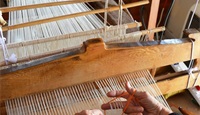
Applicant:
Community Council of Phyti
Communities Concerned - Bearers of the element:
Weavers and members of the community of Phyti, Community Council of Phyti, Museum of Popular Art and Weaving Art, Voufa Movement, Laona Foundation for the Revival and Protection of the Cypriot Countryside, Pafos Regional Board of Tourism, Frederick University.
Domain of Intangible Cultural Heritage:
Traditional craftsmanship
Date of inscription:
2016
Geographical distribution:
This type of woven fabric was developed in the Paphos district, with the village of Fyti taking centre-stage and being the district’s main weaving centre, and the village from which the fabric took its name. Up until 1970, they would also weave in the neighbouring villages of Lasa, Simou, Drymou, Drynia, Yiolou, Stato, Houlou, Polemi, Agios Demetrianos and others. Today, fythkiotika are still being created by the few remaining Fythkiotisses (women from Fyti) who still live in the village, or who relocated after wedlock - or for other reasons - to Nicosia and Paphos. The tradition is also carried out by weavers trained by the Cyprus Handicraft Service.
Brief description:
Even though there are no clear indications as to when this art was developed, according to Frenchman Mas Latrie, the art of weaving was particularly prosperous during the Middle Ages, mainly during the Lusignan period (1192-1489). Later on, Elizabeth Alicia Maria Lewis would write with much enthusiasm about these exceptional types of handicrafts in Fyti and the surrounding region in her book A Lady’s impressions of Cyprus in 1893.
Fythkiotika fabrics that are weaved on a voufa, or loom, are called ploumia tis voufas and are characterised by a variety of colours. Initially the colours were red and blue, as they were the only ones the weavers could get a hold of. They were later enriched with other colours, such as yellow, orange and green.
According to the testimonies of Charalambos Mavrellis, founder of the Fyti Weaving Museum, in the 1950’s Nicosia tradesman Costas Christodoulou would trade the fythkiotika by providing weavers with the yarns and coloured threads so they could create fabrics for him, such as siemedes, mantilies, squares and others.
Creation process
The procedure to create fythkiotika is made up of many stages: the gathering of the cotton, clearing it of seeds on the apparos (gin machine), turning it into yarn, wrapping the yarn with the use of an anemi and doulappi (special wooden hand wheel) and syrma (stretching and counting of warp threads, usually done on an outside wall), the gathering of the syrma and placing it on a loom. Nowadays, readymade thread is used, while few weavers know how to pass the thread through the loom (they usually seek the assistance of the Cyprus Handicraft Service).